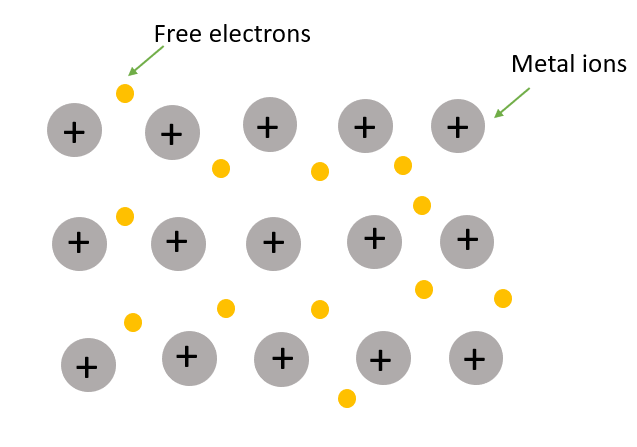
Which of the following is an example of metallic crystalline solids?
(a) \[C\]
(b) \[W\]
(c) \[Si\]
(d) \[AgCl\]
Answer
218.7k+ views
Hint: The solid is a state of matter, in which the constituent particles remain closely packed with the minimum amount of kinetic energy. Generally, solids are recognized for their rigid and hard nature. In most cases they have cubic crystal structures.
Complete Step by Step Solution:
In metallic solids the constituents’ particles i.e., metal atoms are fused together by metallic bonds.
In metallic solids, the positively charged ions are evenly distributed in the crystal and surrounded by free mobile electrons.
In metallic solid the mobile electrons are not held between a couple of atoms i.e., they can delocalize. On the other hand, the metallic solid possesses a sea of electrons everywhere (Image 1).

Image 1: Structure of metallic solid.
In metallic solid each atom can share one or more electrons to the sea of mobile electrons. These behaviours cause an increase in the electrical and thermal conductivity of metallic solids.
Metallic crystalline solids are malleable and ductile i.e., they can easily convert into sheets and wires respectively.
Unlike covalent solids, they are stiff or brittle in nature because the cations can slide into the sea of electrons without breaking any bond.
Metallic solids such as copper, gold, zinc, tungsten, etc. are examples of such solids.
Therefore, option (b) will be the correct answer because silicon, carbon and \[AgCl\] are not metals. While \[W\] is a metal.
Note: The metallic solid can be pure, or they can be the combination of two or more than two metals. Bronze is alloy and it has the mixture of two metals i.e., copper and tin.
Complete Step by Step Solution:
In metallic solids the constituents’ particles i.e., metal atoms are fused together by metallic bonds.
In metallic solids, the positively charged ions are evenly distributed in the crystal and surrounded by free mobile electrons.
In metallic solid the mobile electrons are not held between a couple of atoms i.e., they can delocalize. On the other hand, the metallic solid possesses a sea of electrons everywhere (Image 1).

Image 1: Structure of metallic solid.
In metallic solid each atom can share one or more electrons to the sea of mobile electrons. These behaviours cause an increase in the electrical and thermal conductivity of metallic solids.
Metallic crystalline solids are malleable and ductile i.e., they can easily convert into sheets and wires respectively.
Unlike covalent solids, they are stiff or brittle in nature because the cations can slide into the sea of electrons without breaking any bond.
Metallic solids such as copper, gold, zinc, tungsten, etc. are examples of such solids.
Therefore, option (b) will be the correct answer because silicon, carbon and \[AgCl\] are not metals. While \[W\] is a metal.
Note: The metallic solid can be pure, or they can be the combination of two or more than two metals. Bronze is alloy and it has the mixture of two metals i.e., copper and tin.
Recently Updated Pages
Is PPh3 a strong ligand class 12 chemistry JEE_Main

Full name of DDT is A 111trichloro22bispchlorophenyl class 12 chemistry JEE_Main

Sodium acetate on heating with soda lime produce A class 12 chemistry JEE_Main

Find the isoelectric point pI of Lysine A 556 B 974 class 12 chemistry JEE_Main

The order of basicity among the following compounds class 12 chemistry JEE_Main

The number of isomers in C4H10O are a7 b8 c6 d5 class 12 chemistry JEE_Main

Trending doubts
JEE Main 2026: Application Form Open, Exam Dates, Syllabus, Eligibility & Question Papers

Derivation of Equation of Trajectory Explained for Students

Hybridisation in Chemistry – Concept, Types & Applications

Understanding the Angle of Deviation in a Prism

Understanding Collisions: Types and Examples for Students

Understanding Atomic Structure for Beginners

Other Pages
NCERT Solutions For Class 12 Chemistry Chapter 1 Solutions - 2025-26

NCERT Solutions for Class 12 Chemistry Chapter Chapter 7 Alcohol Phenol and Ether

NCERT Solutions ForClass 12 Chemistry Chapter Chapter 8 Aldehydes Ketones And Carboxylic Acids

JEE Advanced Marks vs Ranks 2025: Understanding Category-wise Qualifying Marks and Previous Year Cut-offs

Haloalkanes and Haloarenes Class 12 Chemistry Chapter 6 CBSE Notes - 2025-26

Solutions Class 12 Chemistry Chapter 1 CBSE Notes - 2025-26




